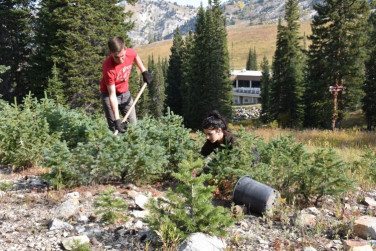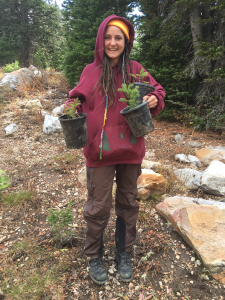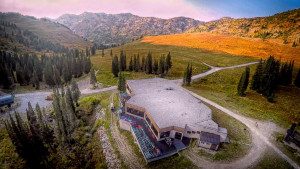
By Shaun Daniel, ENVST Program Research Associate.
As skiers hit the slopes this winter, they should pause to notice the careful forest conservation efforts that Alta Ski Area is undertaking with the U’s Environmental and Sustainability Studies (ENVST) Program and other community partners. This relationship has led to the planting of over 1,200 trees and is providing students with hands-on opportunities to put their learning into practice.
Since 2013, Alta Environmental Center (AEC) has hosted a service learning project and fall orientation for ENVST 2000 Field Experience: Environment and Sustainability, a core introductory course for all ENVST students.
As an introduction to Environmental and Sustainability Studies, the course lays a foundation for the program’s mission to “foster an understanding of ecological systems and the consequences of human-environment interactions.” This dovetails with AEC’s own efforts to improve the sustainability of Alta Ski Area’s operations, serve as a resource to the community, and foster environmental education and research.
The association between Alta and the ENVST program began after Associate Director Jennifer Watt approached Maura Olivos, sustainability coordinator for AEC.
Watt says, “For me this has been a great partnership for the field class, undergraduate research and internships. Working with Maura and the Alta staff has made it much easier to take 50 students camping overnight each semester. As our major has grown and we have so many more students, I don’t know if we would be able to maintain the core concepts of this class without the help of Maura and the Alta Environmental Center.”
Olivos concurs, saying, “Alta Ski Area values its relationship and partnership with the University of Utah because of the body of people – staff, professors and students. To work with folks that are looking to learn, share what they know, share common values in environmental science and the outdoors, and are just fun to be around makes for a great friendship. …It’s a holistic or full-circle effort when it comes to creating opportunity in learning, working and conserving with students.”
Olivos explains that AEC works with the field experience course “to collectively introduce conservation, and through hands-on activity to show the work, planning and complexities it takes to be effective, or what it means to actually work in this field if the students choose to pursue it post undergrad.”
During their field experience, ENVST students engage in such activities as nursery maintenance, tree harvesting for later transplantation, and tree planting survival studies. In the future, students also will help with trail maintenance and restoration.
Assistant Professor Jennifer Shah says, “Service learning is one of a variety of methods to meet the goals listed in our mission. It is a great way to encourage peer learning as students form community bonds. It teaches social responsibility and leadership through service. We also discuss scientific concepts that provide the context for our service projects at Alta.”
She adds, “Sometimes the experience is transformative for students, helping a student to choose a particular career path or valuing volunteerism as a regular activity.”

Anna Albertsen is one of the students impacted by the partnership. A senior now, Albertsen had participated in the service project at Alta and wanted to contribute further. She applied for a grant from the Undergraduate Research Opportunities Program (UROP), which is open to all undergraduates interested in research or creative projects. Albertsen’s proposal was selected and she teamed up with Jennifer Shah and Jennifer Watt as her faculty mentors to quantitatively assess the efficacy of AEC’s tree planting project at Alta.
AEC is focused on enhancing the resilience of the forest around Alta by collecting seedlings of limber pine, Douglas fir, and Engelmann spruce. These are moved to an onsite nursery until they are planted where needed for to replace natural tree loss and support greater forest species diversity and stand diversity.
Albertsen says, “The trees that we’re planting are taken from the same habitat, and the seeds are collected from the location in order to preserve the assemblage of species found at Alta.”
Of the 1,200 trees planted by students so far, around 200 trees have data collected with regard to location, survival rates, and their growth over time. Albertsen analyzed this data to discern trends and suggest improvements.
Albertsen continues, “For the last project, we had a low survival rate, but data collection was also inconsistent. We now know to take a little more care with planting. We also noticed that if [seedlings] survived for a year, they were likely to persist. So, establishment of the plant in the first year is important.”
Now, with another award from UROP, Albertsen is studying the potential link between mycorrhizal fungi and sapling health at Alta. Fungi are increasingly understood to play a vital role in forest health, creating a biological network in which trees have greater access to water and minerals and in turn share nutrients and information with other species through this fungal “wood wide web.”
About the new research project, Albertsen says, “I’ve always been interested in the environment and environmentalism – trying to see how the world works. I found out about fungi and was really fascinated by how much they do and that there’s this stigma around them. If we want to move toward a biocentric way of being as a population, then fungi are an important part of that.”
Albertsen has already gathered tree seedlings from the slopes at Alta and collected measurements on such factors as tree height, biomass, soil moisture and water holding capacity, and root colonization by mycorrhizae. Next, she’ll run statistical analyses to determine if correlations exist between the mycorrhizae and metrics of tree health – illuminating another potential piece of the puzzle for tree planting survival at Alta.

After graduation, she remarks, “I’m hoping to continue researching mycology and maybe focus on a bioremedial aspect therein. By doing undergraduate research, and doing my own research and experimentation, I’m hoping it will provide me the skills I want to have for my future work, or maybe further education, such as a PhD program.”
The research and tree-planting work by Albertsen and others underscores the opportunity presented by the ENVST program’s partnership with Alta Environmental Center. Over time, this relationship has expanded to include a full-tuition sustainability scholarship offered to two students for two years in 2013, and, more recently, the Alta Sustainability Leadership Awards, awarded to exemplary students, faculty, and community members in 2015 and 2016. (Nominations for this year’s awards will open in the new year.)
As Olivos says, “We hope to stimulate a culture of education by way of example through internal efforts and investing in our future stewards.”
No doubt Albertsen and other ENVST students will be among those stewards.
Students interested in working with Alta Environmental Center can look to its internship opportunities: a winter project-based internship, a new sustainability communication internship, and a paid summer stewardship internship. Information on each is available on AEC’s website.
Shaun Daniel is a research associate with the Environmental and Sustainability Studies Program and an alumnus of the Environmental Humanities Graduate Program.
